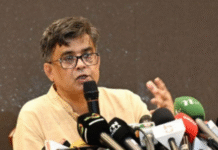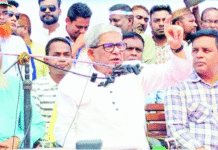
Around 37 percent of the country’s total area has been flooded, said Prof AKM Saiful Islam, of Buet’s Institute of Water and Flood Management, after analysing satellite images.
People of low-lying areas are the worst affected victims of this natural disaster. Some of them have been waterlogged for over a month, he told The Daily Star yesterday.
In 1998, around 68 percent of the country was inundated, 61 percent in 1988, 42 percent in 2007 and 2017, and 38 percent in 2004, Prof Saiful mentioned.
Over 50 lakh people of 150 upazilas in 31 districts have been affected by the flood, said the latest report of National Disaster Response Coordination Centre.
Meanwhile, the flood situation may deteriorate further in the northern region as well as in the low-lying areas around the capital.
Water level of the rivers around the capital may rise today, while that of the Teesta and Dharala in the northern region may increase till tomorrow.
Seventeen rivers were flowing up to the danger marks yesterday, said the bulletin.
Our district correspondents report on the flood situation.
In Tangail, fresh areas have been flooded after a 30-metre portion of a flood protection dam collapsed at Naogaon in Sadar upazila yesterday.
“The embankment was in a bad state. We tried to protect it by dumping geobags for the last couple of days. But it finally collapsed, said Sirajul Islam, executive engineer of Water Development Board (WDB) in Tangail.
Although water has started receding from some areas, the flood situation still remains unchanged.
Premises of Kumudini Hospital in Mirzapur, founded by philanthropist Ranada Prasad Saha, have gone under knee-deep water, causing hardship for patients.
Around 5.41 lakh people were affected in 11 out of the district’s 12 upazilas. Some 750 villages, 89 unions, and six municipalities were hit by the flood.
Three flash floods ravaged houses, farmland, and roads of low-lying areas of all upazilas and four municipalities in Sunamganj.
The Surma and Jadukata rivers have been flowing below the danger level for the last couple of days. But the river water started increasing from early yesterday.
Such triple strikes by flash floods in a month is a new experience for many people of the district — even the elderly could not recall such a situation.
Torjud Ali, 80, of Jogairgaon village in Sunamganj Sadar upazila, said, “We saw prolonged floods several times, but never saw flash floods hit three times in a month.”
Wahid Miah, another elderly man of Sonapur village of the upazila, echoed similar views and said when the water would recede completely, it could be realised how destructive the floods were.
Meanwhile, road communications remain suspended between Chhatak and Dowarabazar upazilas, Jamalganj and Tahirpur with Bishwambarpur upazilas, and Nabinagar and Dharargaon with Sadar upazila for around a month.
Over 900km of roads were washed away in the district.
In Sirajganj, water level of the Jamuna is slowly coming down. But many people are still waterlogged as the river was flowing above the danger mark.
About 3.38 lakh people have been affected in the district, according to the district relief and rehabilitation office.
The Brahmaputra was yesterday flowing above 30cm of the danger level and the Dharla above 5cm over the danger level in Kurigram.
The flood victims, who took shelter elsewhere, have started returning home since Tuesday afternoon as water is receding, said Ariful Islam, executive engineer of WDB in Kurigram.
[Our correspondents from Tangail, Sylhet, Pabna, and Lalmonirhat contributed to this report]









